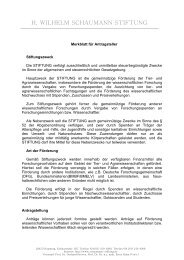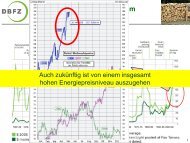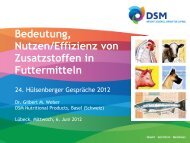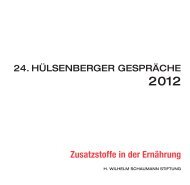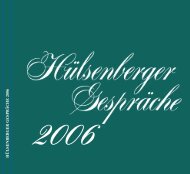Broschüre 2004 zum Download (pdf | 1994,28 KB) - H. Wilhelm ...
Broschüre 2004 zum Download (pdf | 1994,28 KB) - H. Wilhelm ...
Broschüre 2004 zum Download (pdf | 1994,28 KB) - H. Wilhelm ...
Erfolgreiche ePaper selbst erstellen
Machen Sie aus Ihren PDF Publikationen ein blätterbares Flipbook mit unserer einzigartigen Google optimierten e-Paper Software.
FRANK DRIEHUIS and MEIKE C. TE GIFFEL<br />
Developments in silage making and<br />
silage research in The Netherlands<br />
Silage making in The Netherlands<br />
The main crops used in dairy farming systems in<br />
The Netherlands are grass and forage maize. Permanent<br />
grassland represents about 97 % of the total<br />
grassland area and almost exclusively is constituted<br />
of perennial ryegrass. About 10 million tonnes of<br />
grass dry matter is produced annually. Grassland<br />
production in The Netherlands is characterized by a<br />
high N-fertilization rate (on average 250 kg N from<br />
fertilizer per ha), a high annual yield (10 –12 tonnes<br />
of dry matter per ha) and harvesting or grazing at a<br />
young growth stage (2 – 3 tonnes per ha). Grass is cut<br />
for silage on average two times per year. In 2000 grass<br />
silage production was 4.3 million tonnes of dry matter.<br />
There are large differences between European countries<br />
with respect to the popularity of silage making<br />
and ensiling methods practised. In The Netherlands<br />
Figure 1: Estimated production of grass silage, maize silage<br />
and hay in different countries in 2000 (data partly<br />
taken from ref. 1).<br />
about 95 % of harvested grass is preserved as silage<br />
and 5 % as hay. In most European countries silage making<br />
is less popular than in The Netherlands (Figure<br />
1). For example, in Germany about 80 % is preserved<br />
as silage, whereas in France this value is about 20 %.<br />
A characteristic of grass silage production in The<br />
Netherlands is intensive pre-wilting during a short<br />
period, usually about 24 h. As a result, the typical<br />
dry matter concentration of grass silage is high. In the<br />
last decade, the annual average varied between 450<br />
and 500 g/kg, which is substantially higher than in<br />
other European countries (Table 1). For comparison,<br />
the typical dry matter concentration in Germany is<br />
350 g/kg, and in the UK 250 g/kg. The use of silage<br />
additives in The Netherlands is low in comparison<br />
with other European countries (Table 1). In The Netherlands,<br />
on average 5 to 10 % of the grass silages<br />
is treated with an additive. This value is estimated to<br />
be 25 % in Germany and 30 % in the UK. Biological<br />
Table 1: Estimated typical dry matter concentration of grass<br />
silage and additive use in grass silage making in different<br />
countries in 2000 (data partly taken from ref. 1).<br />
Dry matter Additive use<br />
(g/kg) (%)<br />
Germany 350 25<br />
France 270 to 350 10<br />
UK 250 30<br />
Poland 220 to <strong>28</strong>0 12<br />
The Netherlands 450 to 500 5<br />
76



